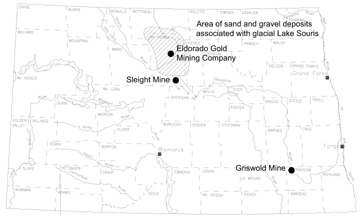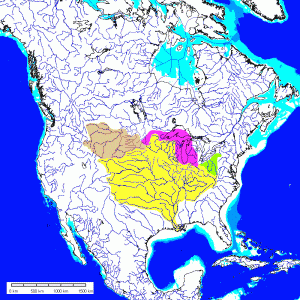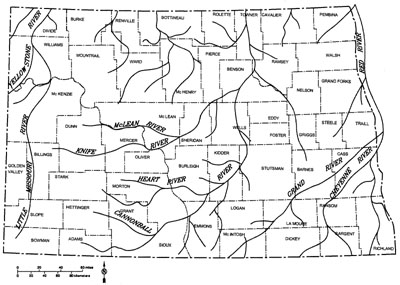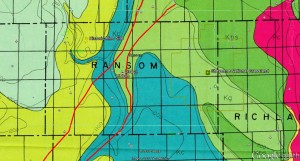Edit: Due to the popularity of this post and addictive nature of panning this post has morphed into a new project.
https://UMWGold.com Information page
https://Forum.UMWGold.com Community form prospectors in the Upper Midwest.
Introduction
The more research I do the less likely I feel I am to find any placer gold in North Dakota, but you probably found this site because you are on the same search. There are no native volcanic rocks exposed on the surface so there is no local source of gold. Any gold that is found in North Dakota is imported via river, glacier, or robbery.
History:
North Dakota has only had three official active gold mines in its recorded history. None of them proved to be economic for any significant length of time.
John P. Bluemle believed that the Eldorado and Sleight mines were located in glacial deposits while the Griswold mine was a river deposit from the periglacial river system that flowed North from the Black Hill in South Dakota.
Rivers:
Pre-glacial rivers were nothing like what we see today. The majority of major waterways flowed North into the Hudson Bay as illustrated below in the comparison (click to enlarge either map).
Since the purpose of this post is focused on North Dakota we will enlarge that area.
If we combine the information we see in the map of North America and the pre-glacial river map of North Dakota we can assume that the Grand River and Cheyeene River likely originate somewhere near the Black Hills and their gravel load is expected to contain some gold bearing sediment.
Glaciers:
Glacial sediment can contain gold, but the glacial lobes responsible for depositing gold in North Dakota primarily moved material in from Northwest. The James and Des Moines lobes picked up much of their sediments in geologic basins that contain marine sediment which contains little or no gold. Material from the Northwest contains a smaller volcanic component than the material deposited from lobes that pushed in from the Northeast off the Canadian Shield.
Additional research and thoughts:
I have a background in geology so I know that artiest can make really nice pictures of paleao-environments without understanding the science behind it. Taking what I had learned from the basic maps I could find I wanted to find locations that may have been overlooked for gold. My personal feeling is that most of the gold deposits in North Dakota probably originated in the black hills and any number of gold bearing mountain ranges that contribute water to the pre-glacial Yellowstone and Missouri Rivers. I also think that the Eldorado and Sleight mines may just be reworked paleo-river channel deposits (Still technically a glacial).
To identify test locations the first order of business is to identify all of the gravel deposits in North Dakota. You are probably not going to find gold in clay unless it is near a contact of a gravel and clay zone (false bedrock). Luckily North Dakota has a lot of gravel roads so gravel is an important resource. NDSU had a map available in PDF format. I converted that to JPG with is available below.
Next we need to find any locations where the Paleo-River channels were exposed in modern times, and determine if they even really existed. How do you identify pre-glacial river channels? For that you have to look at the bedrock topography. Before the glaciers came in and messed everything up North Dakota would have looked similar to unglaciated portions of South Daktoa. ie. basically the same 😐 The hills were a little bigger and the river channels would have been clearly defined in the Pierre Shale which happens to cover a massive part of Eastern North Dakota as bedrock. North Dakota is home to a large amount of oil drilling activity, and the down hole information has been used to make a map of the surface of the the bedrock. (and just about every other geologic formation you can think of) That map can be downloaded at this link (see MM-25 Note: the file is over 200MB)
Now to see if there are any places that contain gravel deposits in ancient river valleys that were covered by glaciers and then re-exposed by glacial out wash channels that removed the glacial overburden. As noted by Bluemle the Griswold mine was supposedly one such deposit. To test his hypothesis (as I expect he did) I made an image overly. Google earth makes the process a painless operations, but my map isn’t perfect due to the fact that the projections are slightly different and I was to lazy to correct it because it correlated fairly well.
Here we see that the historic mine is left high and dry above the river channel. What we may be seeing is a lateral migration of the river channel over time as it down cuts. The less developed river channel probably existed to the west. The gold may have been deposited when the black hills were still young over 40 million years ago. Regardless there is some correlation between the bedrock topography and the Paleo gold deposit. Some of you may think that I am full of it right now. Keep in mind that 38 million years is a long time for rivers to migrate. Just because we can’t see a clear channel on our bedrock map does not mean that it never existed.
The information above provided some confidence in the old maps, but it needs to be understood that the maps are general. Regardless, I spent a little time combining the information for those of you that do not have or want to use Google Earth.
If you know how to use google earth I have also made all of the images available as layers. You can download the file below.
Google Earth North Dakota Image Overlay – Pre-glacial Rivers – Gravels – Bedrock topography
The maps are partially georeferenced, but I did not have the right software at home to do it properly. You will need to move the layers around a little bit to get your area of interest aligned. (Right click on the layer and hit properties–>location tab to move and manipulate.)
Conclusions:
I do not see any obvious locations that are sure to have gravels that originated in a gold bearing rivers, but I have a few that are suspect. Next summer I may conduct a few sampling trips to see if I can find any gold in North Dakota. If you happen to find any gold based off the information you found here please let me know. North Dakota is not likely to have any deposits that would considered be anything more than recreational panning, but it is still fun to look for treasure.
References:
These aren’t exactly in order good luck.
https://www.dmr.nd.gov/ndgs/ndnotes/Gold/Gold.asp (John P. Bluemle’s write up on gold in ND)
https://www.uwgb.edu/dutchs/research/what-if/whatif.htm (Comparative maps of north A
merican rivers pre and post glaciation)
https://www.ndsu.edu/nd_geology/nd_maps/sandmap.pdf (Gravel Map)
https://www.dmr.nd.gov/ndgs/Publication_List/pdf/MIS%20MAPS/MM-25.pdf (bedrock topo)
https://www.d.umn.edu/~pmorton/4110/notes/001_Mn_Quaternary.pdf (Glacial Lobes Picture)
https://gemology.knoji.com/finding-gold-in-north-dakota/ (I didn’t really use anything out of this, but it is well written.












I found this very interesting as I have done extensive research for gold in ND as I am originally from Bismarck and now live in Fargo. I am not a geologist but a hobby gold hunter. I have found pockets of gold in various parts of ND but nothing significant. If you have any interest in my findings and locations, feel free to email me at [email protected]
Thank you
Val Im from Idaho this is my second year I will be working in north Dakota, I also prospect Ive done a lot of research on placer mining there and see its going to be a challenge. Im going to bring a mini highbanker. and a 2in dredge to sample prospect with if you would like to get together email me I will be in Williston thanks
Welcome to the patch. I’m also switching jobs. I will be starting out there in about two weeks. I will still be based out of Grand Forks for awhile. As far as I know there is basically nothing in the Williston area.
I have wanted to try the gravel deposits in the southern part of the state, but I don’t think I will find much. I have been near the source of that river. Flow rates are probably so low that it would have a hard time moving material from the black hills into the state. In addition most of that runoff would have originated on the back side of the black hills which has a lot less gold.
Realistically you might be better off to check out the Little Rockies. I’m not sure what areas if any are open to prospecting. https://www.deq.mt.gov/abandonedmines/linkdocs/155tech.mcpx
I don’t think your highbanker or dredge will do you much good there.
just browsing threw the internet as me and my husband would like to do a little gold hunting. we live in thief river falls, mn. so am trying to find out if there are any close spots to fiddle with.
I have recently become interested in gold mining for a hobby. My dad has a quarter of pasture and I have always thought there might have been a river there at one time. I was looking at your maps above and it shows one of the pre glacial rivers running through our pasture or within a mile or two of it. Definitely going to have to go over there and do some panning. Thanks for the info!!
Yeah, the maps provided are fairly general. I did not properly georeference the images so some of the overlays are off by quite a bit.
Realistically the only preglacial rivers that you will expect to find gold in are the ones on the far Eastern side of the state and far western side of the state.
Cannonball, Little Missouri(not much in this one), and Yellowstone should have all had gold. The sediment source was likely not correct for the rivers that ran in the central part of the state. That said I have checked some of the gravel deposits fro those rivers anyway. So far I haven’t had any luck. There is some glacial gold in North Dakota as well.
Dear Dr. Bluemle,
I am very much interested in your detection of what you call a hogback. I am an architect from Germany and I have found out quite a lot on ancient things. May be that I could give you an interesting explanation on your hogback. But it would be no Ice Age. As you can read on my homepage there have been pole-shifts of Earth in the past, in historical times. There must be a large forgetting in the past. I would be appreaciated by an answer of you.
Best wishes
Martin Lutze.
PS Your name is coming from Germany, right from my region, from Suebia. I am much surprised.
Unfortunately, Dr. Bluemle did not write the article. However, I have met him and I do not think he would be very open to your ideas of pole shifts.
Sir Names originating in Germany are very common in North Dakota.